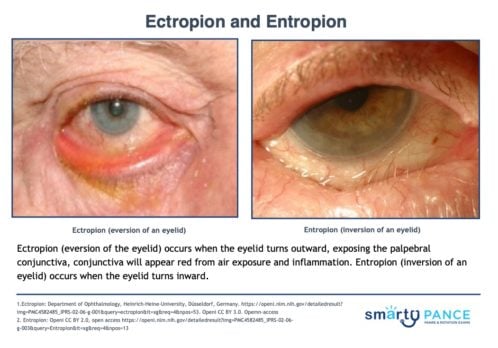Patient will present as → a 73-year-old male who complains of dry eyes coupled with excessive tearing. On exam, you note the conjunctiva appears red, and the right eyelid is turned outward.
Ectropion is an eversion (outward turning) of the eyelid caused by age-related tissue relaxation, cranial nerve VII palsy, and posttraumatic or postsurgical changes.
- Ectropion occurs when the eyelid turns outward, exposing the palpebral conjunctiva
- Ectropion is usually caused by muscle and ligament relaxation due to aging. It may also be caused by scar tissue from injury or previous surgery
- Tearing and symptoms of dry eyes (due to poor drainage of tears through the nasolacrimal system, which may no longer contact the eyeball)
Diagnosis is clinical (eyelid turns out)
Symptomatic treatment can include tear supplements and, at night, ocular lubricants
- Definitive treatment is surgery
Question 1 |
A 70-year-old man presents with complaints of chronic tearing and irritation in his left eye. On examination, the lower eyelid is noted to be turned outward, exposing the conjunctival surface. This condition is most commonly associated with which of the following?
Neurogenic causes Hint: Less common and usually associated with facial nerve palsy. | |
Allergic reaction Hint: Typically causes eyelid swelling but not ectropion. | |
Infectious etiology Hint: Infections can lead to eyelid changes but are not a common cause of ectropion. | |
Involutional changes | |
Traumatic injury Hint: Can cause ectropion but is less common than age-related changes. |
Question 1 Explanation:
Involutional ectropion is the most common type of ectropion and is typically associated with aging. It results from the relaxation of the eyelid tissues due to age-related changes, leading to the outward turning of the eyelid.
Question 2 |
A 71-year-old male presents to your clinic complaining of dry eyes coupled with excessive tearing. On examination, the conjunctiva appears red, and the left eyelid is sagging and outward turning (ectropion). What is the most appropriate initial treatment for this patient?
Tear supplements and ocular lubricant | |
Immediate referral to Ophthalmology to discuss surgical options Hint: While surgical correction is the definitive treatment for ectropion, initial management should focus on symptomatic relief with tear supplements and lubricants. | |
Topical antibiotic eye drops Hint: These are not indicated in the absence of an infectious process. | |
Topical steroid eye drops Hint: Steroids are used for inflammatory eye conditions but are not indicated for ectropion without underlying inflammation. | |
Warm compresses and eyelid massage Hint: These are more appropriate for conditions like blepharitis or meibomian gland dysfunction, not for ectropion. |
Question 2 Explanation:
In a patient presenting with symptoms of dry eyes and excessive tearing due to ectropion, the initial treatment should focus on symptomatic relief. Tear supplements and ocular lubricants can help alleviate the dry eye symptoms. While surgery is the definitive treatment for ectropion, initial management with lubrication is essential to provide comfort and prevent complications associated with dry eyes.
Question 3 |
An 80-year-old patient with severe involutional ectropion is experiencing constant tearing and recurrent conjunctivitis. What is the most definitive treatment for this condition?
Lubricating eye drops Hint: Provide symptomatic relief but do not correct the underlying problem. | |
Eyelid taping Hint: A temporary measure to reposition the eyelid. | |
Surgical correction | |
Topical antibiotics Hint: Used to treat secondary infections but do not address the ectropion itself.
| |
Botulinum toxin injection Hint: Not a standard treatment for ectropion. |
Question 3 Explanation:
Surgical correction is the most definitive treatment for severe involutional ectropion, especially in cases with symptoms like constant tearing and recurrent conjunctivitis. Surgery typically involves tightening the eyelid and its attachments to restore normal eyelid position and function.
There are 3 questions to complete.
|
List |
References: Merck Manual · UpToDate


